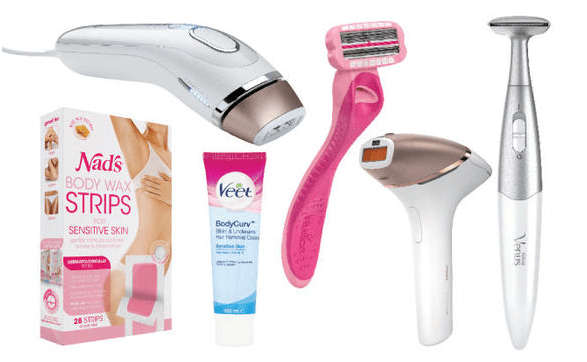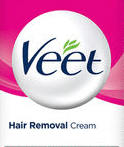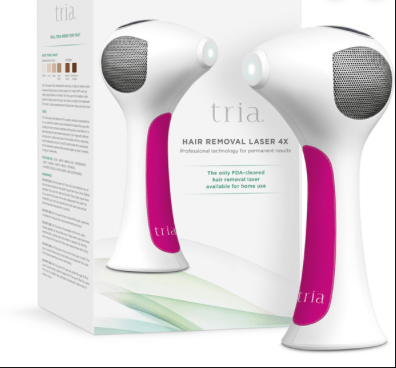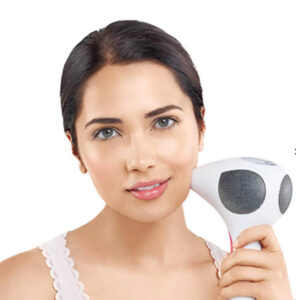When we see the sun shining, and feel the warm weather on our skin, it does wonders for our bodies. We like nothing more than stripping down to our bathing costume and getting color to our pale winter complexion. But with it comes the extra burden of having to shave, wax, and laser exposed, unwanted hair on our bared bodies. So, allow us to share with you The 7 Best Hair Removal Techniques – The Ultimate Guide For You And Your Body.
The Smooth Silky Feel Of Hair Free Skin

Some of the options available to us are – shaving, waxing, laser, or epilators. But which method is best when it comes to expense, comfort, and convenience? Learn the pros and cons of the most popular techniques and the best devices available for people who prefer the ‘smooth, silky’ feel of hair-free skin.
For some people, the preference is to leave the hair to grow as nature designed. After all, we do grow hair on our body for a reason – warmth, hygiene, and to protect against uncomfortable friction.
For others, no reason justifies the sight of a hairy body, and they search for a hair removal process to remove every last strand growing from the eyebrows down! It’s a personal decision, and ultimately your choice, but once you find your solution, it’s a blissful ‘hair-free’ result.
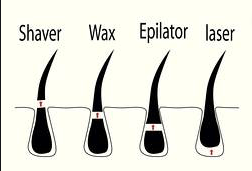
Before you decide on the method to display a smooth ‘beach-babe’ body this summer, make sure your preferred hair-removal technique is kind to your skin. Read on to find your preferred weapon!
Shaving
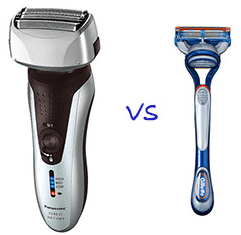
The razor is the cheapest, and one of the simplest methods we rely on to remove hair. The big drawback with this is that it can leave your skin bumpy, stubbly, and even bloody if you are not careful with the razor!
Another unwelcome problem is ‘ingrown’ hairs. Due to the razor cutting the hair at an angle, it tends to regrow inward, especially if the hair is curly. The result is bumpy and inflamed, and often infected skin which will not resolve until you remove the ingrown hair.
Other possible complications as a result of shaving include scarring, breaking fine capillaries when removing the hair and hyperpigmentation – permanent dark marks after healing.
One possible benefit of using the razor is that it does have a moderate exfoliating effect. The blade removes dead skin cells from the surface as you shave, which leaves skin feeling smoother.
How can you prep beforehand?
Hair becomes 60 percent easier to cut when it’s softened in a warm bath for two to three minutes beforehand. Certain products are available to make shaving more straightforward, like Venus’s Satin Care. Applied before shaving it will aid the process and ensure that skin is well-nourished and hydrated. In contrast to other hair-removal methods, hair length is not such a relevant factor so that you can do it as and when required!
How long will it last?
Don’t go with the shaving method if you are looking for the ‘remove and forget’ system! Shaven skin doesn’t last long, and the length of time can depend on individual skin pattern. If you go with the wet shave procedure, you can expect results to last somewhere between one and three days. But dry shaving will get you less, only 24 hours of smooth skin.
Wet Shaving
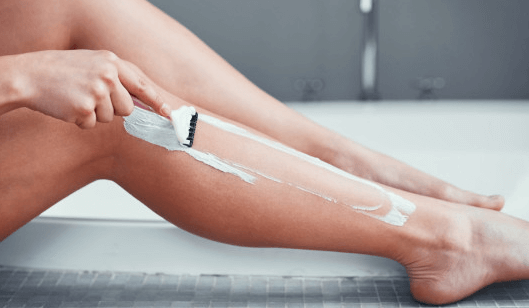
How It Works:
To remove hair first apply moisturized shaving lotion/gel, this allows for blades to glide over moistened skin. Using long clean strokes go against the direction of the hair growth, pulling the skin taut.
Best For:
Underarms, bikini area, and legs.
Advantages:
Shaving is a convenient option; it’s painless and effective, also gently exfoliates dry, flaky skin on legs to keep them looking extra-smooth. Wet shaving gives a very ‘close’ smooth shave.
Disadvantages:
While shaving does reveal beautifully smooth skin, you have to keep on doing it frequently, almost on a daily basis to maintain the smooth results!
Effectiveness:
An excellent choice for busy women
Electric Shaving
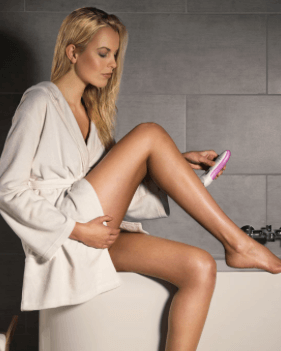
How It Works:
Passing a small electrical machine with a fine mesh screen covering the blades across the skin’s surface, catching hairs. Blades move laterally, cutting the hairs against the edge of the screen.
Best For:
Legs, bikini area, underarms
Advantages:
Quick, safe, and convenient, and because you do it ‘dry,’ it’s easy to do on the go. Suitable for most people and a good option for those with sensitive skin.
Disadvantages:
The smooth feel doesn’t last quite as long as wet shaving. A little more maintenance required, the shaver needs looking after properly, with regular cleaning and replacing the blade annually.
Effectiveness:
Excellent as a gentle and quick hair removal method.
Hair-Removal Creams
 Hair removal creams like Veet and other specific creams work by dissolving hair at the skin level. Once applied and left for the set time, you then use a ‘spatula’ type tool provided or use a cloth or sponge to wash away the cream with the ‘broken’ hairs. The remainder of the hair stays in the follicle and is ‘detached’ evenly, this means there is less chance of getting ingrown hairs when the hair starts to grow back.
Hair removal creams like Veet and other specific creams work by dissolving hair at the skin level. Once applied and left for the set time, you then use a ‘spatula’ type tool provided or use a cloth or sponge to wash away the cream with the ‘broken’ hairs. The remainder of the hair stays in the follicle and is ‘detached’ evenly, this means there is less chance of getting ingrown hairs when the hair starts to grow back.
All of this sounds perfect for you; well hold on for a moment before making a decision.
No Pain – But Is That The Full Story?
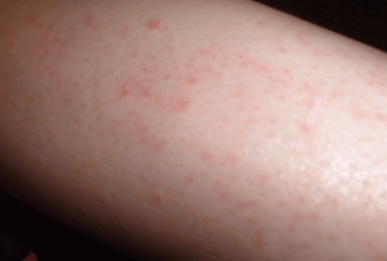
Of all the hair removal options available to you, depilatory creams are, without a doubt the least painful. So, if your pain threshold is low, and the thoughts of putting a razor near your delicate parts brings you out in a cold sweat, but you still feel the need to remove hair, creams are as gentle an option as they come.
It is an excellent choice for those hard-to-reach and more sensitive areas of the body. Hair removal creams are also a great starting option for those wanting to remove hair for the first time.
However, don’t think these creams come with a risk attached to them. These products can give you chemical burns because they are strongly alkaline. A burn wound is more likely to occur if you leave the product on for longer than instructed on the packaging.
Certain types of hair are not removed effectively within the time frame stated; therefore, patients will leave them on longer. By the time the hair gets dissolved, the skin gets burnt.
Before you decide to use hair removal creams, consider what your skin type is. If you have sensitive skin that generally reacts to chemicals in cosmetics, it may be best to stay away from this type of hair removal. If you decide to use them, be sure to do a ‘skin patch’ test to ensure your skin can tolerate the chemicals in them. You must read the instructions thoroughly before using.
How long will it last?
As the hair breaks off just below the skin’s surface, you can expect regrowth in around two to three days. All the surface hair will be removed, with smooth skin is achieved quickly, but the results are not as long-lasting as other methods.
Depilatory Creams
How It Works:
Apply the cream to the area you want to remove the hair. Ensure that every strand is covered so the cream will chemically start dissolving the hair at the surface of the skin. Look at the recommended timings on the packet for the correct time needed for it to work. Set your alarm do not second guess how long to leave it on. When time is up, take the plastic spatula and scrape away the cream or step into the shower and wash the unwanted hair away. Make sure you remove the cream thoroughly, or you risk developing a ‘slow burn’ or allergic reaction.
Best For:
Upper lip, bikini area, and underarms. Probably not suitable for larger areas.
Advantages:
Pain-free, simple to do and inexpensive. If you’re prone to shaving rash, then hair removal cream could be an excellent option to consider. Unlike when you use razors, it doesn’t cut the hair at an angle. You are less likely to get that irritated, itchy feeling when the hairs grow back or the dreaded ingrown hairs!
Disadvantages:
Can be messy and difficult to apply, and not that suitable for doing large areas. Skin irritation can be a problem from chemical ingredients, so it’s best to do a skin patch test the day before you apply to a large area.
Effectiveness Rating:
Best for doing smaller areas like face and underarms. It does leave the treated area hair-free and smooth.
Epilation Root Hair Removal
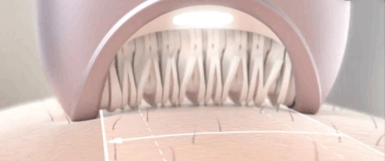
With this method, you remove your body hair by the root, no ‘slicing’ off from the top here! It takes a few weeks for the hair to grow back, and when it does, it is usually softer and thinner than before. The real benefit of using these hair removal methods is that it lets you enjoy smooth skin for up to 4 weeks, happy days!
Epilators
Epilators are small mechanical hand-held devices that simultaneously pluck multiple hairs from the root. Yes, this may sound like a torture device. Pain tolerance varies in people, and for those with sensitive skin, the thoughts of using an epilator for the first time can be daunting and painful. It may surprise you just how pleasant they are to use, once you get used to them.
Many of the devices that you can buy today are designed to use on wet or dry skin, so they are just as easy to use in the shower as a razor. Some of the better brands remove hair as short as a grain of sand, impressive stuff! That’s four times shorter than waxing – and lasts for up to four weeks.
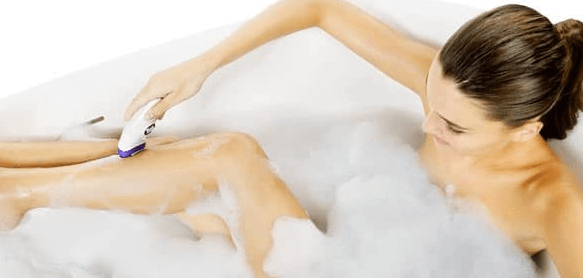
Personal preference is to use the epilator in the bath or shower. The wet skin gives a smoother surface for the epilator to glide across. The hydrated hairs are also more comfortable to ‘pluck’ from the root. With each use of the epilator, you experience less discomfort making it well worth the effort.
How To Make Using The Epilator Less Painful
Warm baths or showers makes the hair softer and open the pores in your skin. Epilating is more comfortable while you shower or just after a warm shower for this reason.
Try exfoliating your skin a few days before epilating to help remove dead skin. Also, exfoliate a few days after using the epilator to minimize the risk of ingrown hairs.
Shave the area you want to use the epilator on 2-3 days before your first session. By shaving, this will reduce the number of hairs available for epilating, and your first time will be less painful. Also, it is an excellent way to begin to condition your skin to tolerate minor pain. Continue to epilate every few days, removing more hairs as they grow out.
Make sure to place the epilator on as flat a surface as possible on tight skin to make it easier to skim along. In areas where the skin is not firm, such as your armpits or upper thighs pull the skin taut so that the device can capture as many hairs in every pass. Fewer passes over the same spot mean less pain.
If your skin is extra sensitive, use a numbing cream to numb your skin temporarily for epilation. You won’t feel the pain as much and is an excellent option for more sensitive areas such as the underarms.
Epilating
How It Works:
By using a hand-held electric device. The device has a head of rotating that uses’ tweezers.’ As you move it along the skin’s surface, it removes hairs as it goes. Because it removes the hair strand from the root, as opposed to shaving that only removes the hair from the skin surface, it is a smoother, longer lasting hair removal technique.
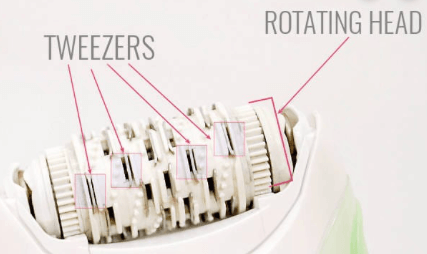
Best For:
Can be used on all body parts – legs, arms, underarms, bikini area, and face.
Advantages:
Ultra-smooth results, lasting up to four weeks. It is mess-free, and new models come with an extra attachment for removing unwanted hair from specific areas such as the face. Most epilators available today can be used on wet or dry skin.
Disadvantages:
It is painful to use, at least until you become accustomed to it, especially in more sensitive areas.
Effectiveness:
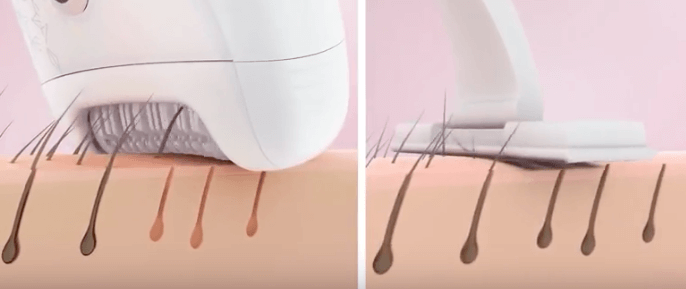
Epilators can remove extremely short hairs, as short as 0.5mm. Unlike waxing which needs hair lengths of 2-3mm for optimal results, so there’s no need to wait for unsightly hair regrowth.
The epilator removes the hair at the root, when it does grow back at around the four-week stage, the tip tends to be tapered, which results in it having a more delicate appearance. Also, regular use of the epilator can reduce the number of ingrown hairs.
Waxing
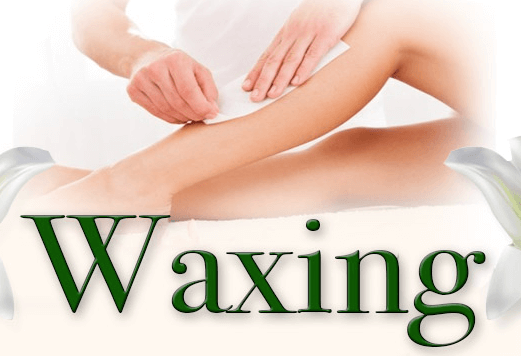
The popularity of waxing as a hair removal choice is mainly due to its long-lasting effects as waxing removes the hair from the root. The hair needs to be relatively long, around 3-4mm in length for the wax to be able to grip and remove the whole strand.
Waxing, like epilating, comes with a severe ‘Ouch’ reputation, you should brace yourself for the most sensitive areas such as the bikini line. The pain is temporary and eases after a few minutes. Long-lasting effects are one of the reasons why this hair removal method has become a firm favorite. The silver lining at the end of your wax treatment is that you won’t have to go through the agony for around four to six weeks.
What Parts Of My Body Can I Wax?
Most people say you can wax from the eyebrows down, but I would advise against using the wax hair removal method on the face.
Waxing, especially when it comes to the sensitive eyebrow and upper lip area can cause significant skin damage as it removes a top layer of delicate skin when you use it. The sensitive, thin skin around the eyes has no oil glands, and you should use as gentle a method as possible to remove hair from this area. It’s fine to use wax on the body, but it’s too rough on the skin around the eyes. Maybe stick to ‘threading’ or ‘tweezers’ when dealing with the eyebrows, and laser as a permanent solution for the upper lip.
If you are thinking of having your first bikini wax, I would recommend having your legs waxed a couple of times beforehand. By doing this, you will get an idea of how it works, and be ready for when your more sensitive areas are to be waxed.
Waxing – How It Works:
Apply hot or cold wax to the skin in the direction of hair growth. Leave it to solidify, and fabric strips are smoothed on and quickly stripped off going against the direction the hair grows, pulling the hair out with it. An alternative option is pre-made wax strips; these are also a little easier to deal with for the do-it-yourself beautician.
Hot wax is spread thickly onto the area to be waxed, and allowed to semi-dry before it is peeled from the surface of the skin. It can also be reapplied a few times without causing discomfort. The benefits include fewer in-grown hairs, less ‘breakage’ and therefore extended regrowth periods.
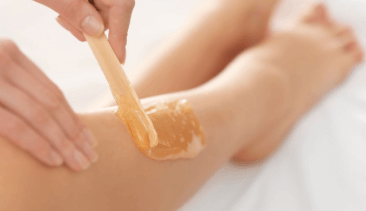
Strip wax, on the other hand, is ideal for use over larger areas with thicker, less sensitive skin. We would recommend this for the legs, back, chest, and arms.
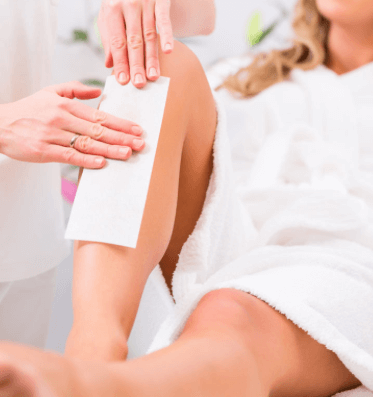
When you use any hair-removal methods that pull the hair from the root, exfoliating the skin is always a good idea. You should prepare from the evening before by using gentle exfoliation to help the hairs leave the root. It’s also essential to remain hydrated, as the more hydrated the skin, the easier the hair strand comes out, so up your water intake beforehand.
Is it best to have waxing done by an expert?
A lot of people avoid waxing the more sensitive areas themselves due to bad experiences. If left to be done by a professional therapist it will give you the best and long-lasting hair-free finish.
Best For:
Legs, bikini, underarms, and upper lip.
Advantages:
Wax can keep skin hair-free for weeks, so you don’t have to think about hair removal for between four to six weeks.
The finer the hair, the longer the smooth look lasts. If the area has been shaved, the smoothness lasts for a shorter period as the hairs tend to grow back thicker after being shaved, and at different lengths. However, with continuous waxing, the number of hair strands decreases, and hair-free time gets longer.
Disadvantages:
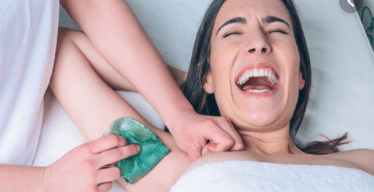
The obvious drawback is that waxing is painful. Also, you have to wait until hairs are long enough before you can wax them again. A problem particularly in the summer if you want to bare your legs or hate the feeling of regrowing hairs. After you wax, the skin can be left dry.
If you decide to do-it-yourself, it can be tricky and a little messy. If you go to a professional salon, it can get expensive. Finally, wax can miss very short hairs.
Effectiveness:
Great if you find having to do hair removal frequently and a ‘hassle,’ and you are seeking long term hair-free skin.
Professional therapists advised that you do not exercise directly after waxing, expose skin to the sun, or apply ‘strong’ cosmetic products for 24 hours.
Threading
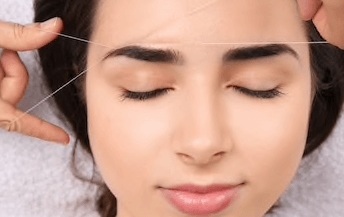
A lot of women now prefer to have their eyebrows and the little annoying hairs on their face removed using threading instead of waxing or shaving. ‘Threading’ is not that traumatic for the skin, making it an excellent option to use on sensitive areas like the eyebrow or upper lip.
The threading method is unlikely to damage skin, as it is gentler than using tweezers, but it has a significant downside. Due to the small areas that are treated with each ‘threading,’ it’s only feasible for use on small areas of the skin.
Threading – How It Works:
Taking a fine length of cotton thread and twining it around each hair, you then pull the thread quickly apart, in doing so you remove the hair along with it.
Best For:
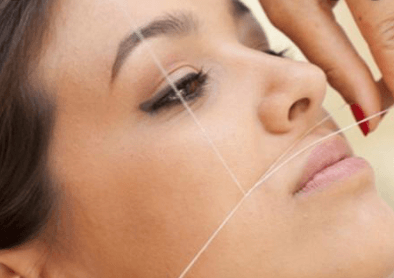
Small, delicate areas – upper lip and eyebrows.
Advantages:
The hairs are removed from the root, so regrowth is slow, and the hairs do not grow back ‘prickly.’
Disadvantages:
A relatively slow process, since the hairs need to be pulled out one by one. It’s quite a specialized procedure, so you should go to a well-trained professional.
Effectiveness:
Great for eyebrows – once women have tried it, most will stay with this type of eyebrow hair removal method.
Tweezers
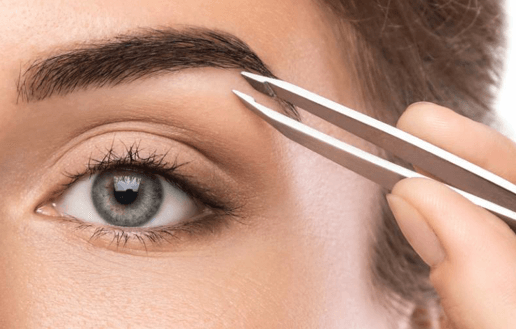
‘Tweezing’ is a perfect way to maintain eyebrows and any unruly stray hairs. The problem is that because it tackles one hair at a time, it’s an arduous method if you want to remove a significant amount of hair. So, when it comes to legs or underarms, it’s best to employ other techniques. If you’re a perfectionist when it comes to having smooth skin, having tweezers on hand after a wax or shave can be helpful to remove the remaining stubborn strands.
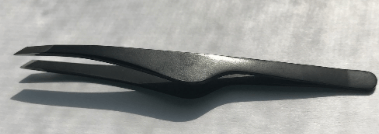
Using tweezers works best when the pores are open to free the hair from the follicles grip. Dab a cold flannel over the skin once you’ve finished, this helps to reduce redness and close the pores, keeping out unwanted infections.
Depending on the type of hair you’re hoping to remove. Use a slant tip tweezers for coarse and longer length hair. For fine strands and stubble-like hairs, the point tweezers would be easier to ‘grab’ using their more delicate tips.
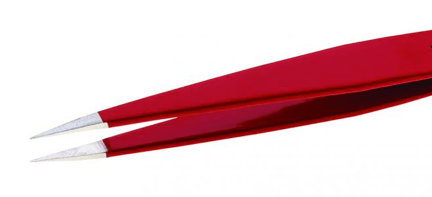
Whether it’s to tidy up your eyebrows or tackling pesky flyaways, tweezers should be a mainstay in your beauty bag.
How It Works:
Take the tweezers between the forefinger and thumb, grasp the hair and quick tug. Always pull the hair in the direction the hair grows to avoid breakage, never yank or tug on eyebrow hairs. Use tweezers with a neat precision tip to isolate, lift, and then pluck the hair from the root.
Best For:
Small, delicate areas – upper lip and eyebrows.
Advantages:
A very effective way to get your eyebrows shaped precisely how you want them, and lasts for around 3-4 weeks.
Disadvantages:
Only suitable for plucking small dealing with small areas. Excessive plucking or applying aggressive skin care treatments can cause eyebrows to fall out
Effectiveness:
Tweezing allows you to shape and get more defined eyebrows. Once you have mastered the technique, you can keep your eyebrows in perfect shape.
Intense Pulse Light
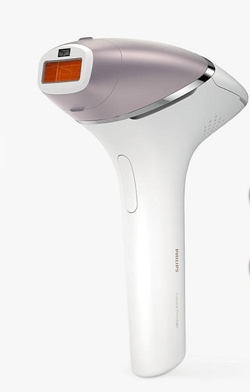
IPL – Intense Pulse Light is a relatively new hair removal method whose popularity has grown over the last few years. It works by sending flashes of light that affect the regrowth of body hair. It is derived from the professional methods used by dermatologists.
IPL is a long-term solution, so should not be your go-to method if you’re after immediate hair removal. It uses a broad-spectrum pulse of light to attack melanin in the hair. The technique can slow regrowth by as much as 92 percent.
How It Works:
Place the machine onto the target area and let the pulse of lights do their thing.
A narrow beam of concentrated light focuses on a small section of skin. The pigment absorbs the light in the hair follicle below the skin surface, heating the hair follicle, and impairing hair growth depending on the stage of the growth cycle. The paler your skin is, and the darker your hair, the more successful the hair removal treatment is going to be.
For IPL to work successfully, there are specific criteria that need to be met.
Dr. Stefanie Williams, a cosmetic dermatologist at Philips Lumea, explains:
“IPL works by targeting the melanin in the hair in contrast to the melanin in the skin. Due to the low levels of melanin in light-blonde, white, grey, and red hair, all light-based hair removal treatments are not effective.
IPL treatment is also not suitable for women with naturally dark skin tones. There is a risk the light may react with the melanin in the skin and not the hair. There are products on the market which claim to be able to treat red and very light blonde hair. However, I would approach these products with caution and ensure that you do plenty of research before purchasing to ensure that it will work for you.” – Dr. Stefanie Williams, a cosmetic dermatologist at Philips Lumea
The area you are treating needs to be hair-free before using the IPL. It is recommended to shave the area as opposed to other methods before using the IPL. For IPL to work, there has to be a hair ‘bulb’ in the follicle. The ‘bulb’ absorbs the light from the device, and the hair root will die and eventually shed the hair.
Wikipedia Advice On IPL
“Contrary to what is often claimed, photo epilation is not a permanent hair removal method but a permanent hair reduction method. Although IPL treatments will permanently reduce the total number of body hairs, they will not result in permanent removal of all hair.” https://en.wikipedia.org/wiki/Intense_pulsed_light
Best For:
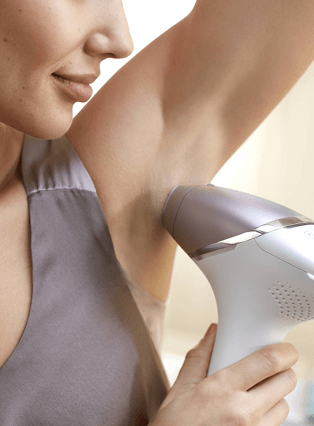
IPL works anywhere on the body that grows hair below the eyes. Many of the home devices come with attachments for different body areas. Before purchasing, it’s important to note your skin tone and hair color.
Advantages:
They are quicker to use now and less painful than it used to be as broader sections of the skin can now be treated in one go. The hair is discouraged from growing back, existing hair sheds naturally, and regrowth is considerably slowed down.
Disadvantages:
The skin requires shaving before each treatment. Results are not permanent. So you need multiple procedures. You should not go in the sun for up to six weeks, either side of your treatment. Changes to the pigment in your skin can increase the risk of sunburn. The closer your hair color to your skin color, the higher the risk of burning and potential scarring.
Intense Pulsed Light (Ipl) Technology
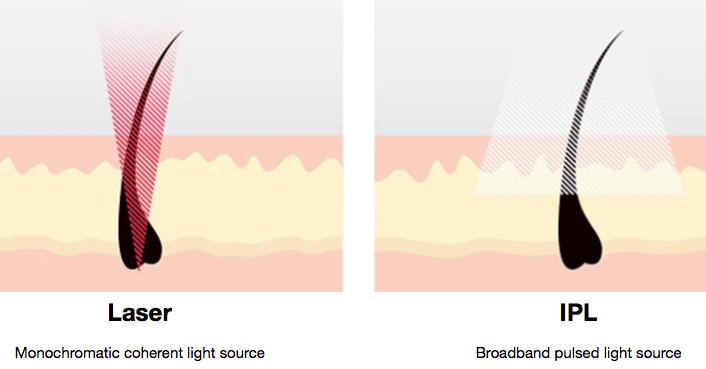
IPL devices provide a broad spectrum of colors and wavelengths, similar to a light bulb. It is not possible to focus the light energy into a precise, concentrated light beam.
The light energy of IPL diffuses on the skin that surrounds the hair follicle. In doing so, it loses some of its power on the surface of the skin, and it is not so precise on the actual hair follicle. For this reason, it works more on hair ‘reduction’ treatment as opposed to ‘permanent’ hair-free solution.
Effectiveness:
An excellent option for areas that cause distress, like the upper lip and underarms. Existing hair sheds naturally, and regrowth is slowed down. Application is incredibly straightforward; you treat the desired area of the body every two weeks for eight weeks, to reduce hair growth by up to 92 percent. After the initial phase, you treat the area every six to eight weeks to maintain the results.
Diode Laser Treatment

If you’re considering using a laser device for hair removal, it pays to do your research first. It’s all too easy to be lured into the promise of a life free from the stress of hair removal. But it’s mightily important to read up on the facts (and side effects) first, and to make sure this procedure is right for you and your skin!
We have seen that when it comes to hair removal, there are a variety of options available to you, from waxing, threading, shaving to tweezing. But laser hair removal is one of the few choices that offer a more permanent approach to getting rid of body hair. The perfect combination to get the best results are – Dark Hair and Fair Skin.
What Is The Difference Between A Diode Laser and IPL Technology?
Both methods will leave your skin smooth and hair-free, yet how do you decide between ‘Laser’ and ‘IPL’ – (Intense Pulsed Light) hair removal methods
Read – Tria Hair Removal Laser 4X Review

A Diode Laser device offers a ‘safe to use at home’ permanent hair Removal solution, whereas IPL offers permanent hair Reduction.
Note the difference – ‘Permanent Removal‘ as opposed to ‘Permanent Reduction.’ The variation may seem irrelevant, but it makes a world of difference to having unwanted hair, and having to go through the process of hair removal every few weeks!
Diode Laser Or IPL – Which Is More Effective?
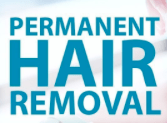 ‘Diode Laser Technology’ is recommended for hair removal with permanent results, while IPL is recommended for hair reduction.
‘Diode Laser Technology’ is recommended for hair removal with permanent results, while IPL is recommended for hair reduction.
Diode Laser Technology
Diode Lasers work by producing a single spectrum of intensely concentrated pure light in one single red color and wavelength.
The laser is exact and targets the dark pigment (melanin) in your hair follicle. It heats the follicle and removes its ability to regrow hair, without touching or heating the surrounding skin.
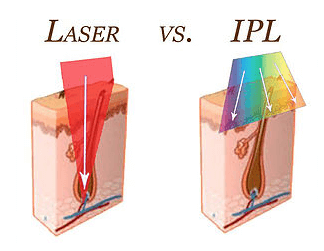
Diode Lasers create more heat and light energy aimed directly to the hair follicle and only target melanin (the pigment that gives hair its color).
Because the laser is so accurate and ‘hits’ only the hair follicle it can offer a more permanent solution to hair removal.
A Diode Laser device is a little more expensive to buy than an IPL device. However, in this case, you are getting a ‘game-changer’ in hair removal, and the answer to finding permanent hair-free skin.
Tria Hair Removal Laser 4X
See On – lookfantastic.com
Using A Diode Laser Device Will Give You:
–Precision: Targets dark, coarse hairs while leaving the surrounding skin undamaged.
–Speed: Treats many hairs at the same time in an area approximately the size of a quarter, every second.
–Efficacy: For all skin types.
–FDA Cleared: Proven through dermatologist-led clinical studies, the Hair Removal Laser is FDA-cleared for safe and effective use.
The inference seems to be that Diode Laser outperforms IPL for hair removal when comparing satisfaction level, safety, and effectiveness.
Worldwide Distribution @ lookfantasic.com
Hair Removal Salon – Or Home Treatment?
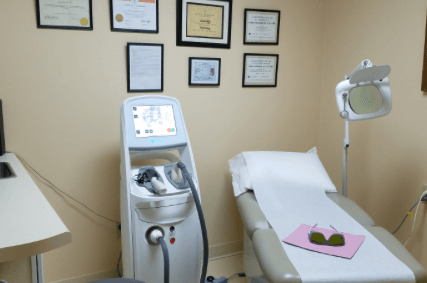
Nowadays, you’ll find a wide range of home-based treatments and Salon Services for hair removal.
Which do you prefer, dealing with your hair removal at home or going to a salon?
Doing it yourself at home will save you time and money, yet, to begin with, you’ll have to do it more regularly. Having hair removal treatment in a salon will give you expert advice from a professional and can lead to faster results. In either case, the outcome is going to be similar – a considerable reduction in body hair.
Summing-up – The 7 Best Hair Removal Techniques
My preference is to deal with hair removal at home. I find it easier to fit it into my schedule and less intrusive. Also, I have found the perfect device for personal use in the Diode Laser. Tria Hair Removal Lasers have three times more hair eliminating energy than any other at-home hair removal device.
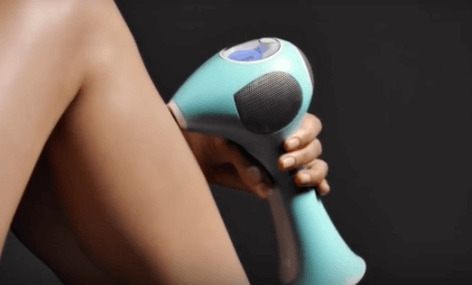
Safe and effective, you’ll get the permanent results of a professional treatment. As it is a permanent hair removal device, I believe that it will ultimately significantly reduce the time I have to spend dealing with hair removal.
I do hope you have found this post on ‘The 7 Best Hair Removal Techniques – Ultimate Guide For You and Your Body‘ to be helpful and informative.
If you have any questions, please leave them in the comment box below, and I will be happy to discuss them with you.

